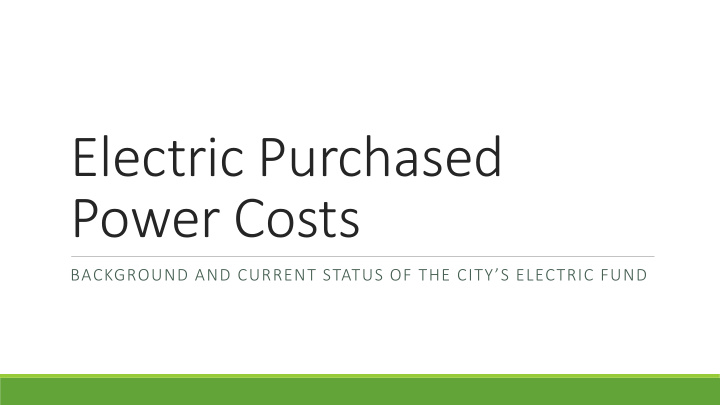



Electric Purchased Power Costs BACKGROUND AND CURRENT STATUS OF THE CITY’S ELECTRIC FUND
2008 Purchased Power Goals Current policy direction on power portfolio goals ◦ Competitively priced ◦ Long-term stable rates on energy ◦ Mitigate regulatory, legislative, and financial risk ◦ 30% renewable by 2030 2008 Integrated Resource Plan (IRP) ◦ 30% Renewable ◦ 30% Coal ◦ 30% Gas ◦ 10% Market ◦ Substitute Nuclear power for Coal or Gas if available
Contract History LCRA Primary Provider of energy from 1940-2012 ◦ Did not renew as they couldn’t meet purchased power goals ◦ Aging fleet ◦ New investments were expensive ◦ No rate guarantees to the City 2008 – Signed small wind contract with AEP as a pass through deal for Southwestern University Utility had no other sources of power at this time
State of markets in 2008-2012 Blocks of Power versus Load All forms of power were 160 expensive to acquire 140 City evaluated multiple 120 options in wind, coal, and 100 MWs gas 80 60 Every option was above 40 electric rate targets 20 0 1 2 3 4 5 6 7 8 9 10 11 12 13 14 15 16 17 18 19 20 21 22 23 24 Hours of the Day Base Load Intermediate Peak Short Long Actual Load
Competitive Procurement of Purchased Power 2012 ◦ LCRA contract terminated ◦ Began competitive procurement for energy (gas, coal, wind, solar, and nuclear) Philosophical design for the utility ◦ Targeted peak vs. base load protection ◦ Targeted future vs. current needs 2008-2012 had shown a high frequency of price spikes during peak demand
Competitive Procurement of Purchased Power 2012 ◦ Mercuria (MEA) contract approved through 2021 (Gas Contract) ◦ No long-term contracts available due to ERCOT forecasting shortage and resulting high energy prices 2013 ◦ Spinning Spur 3 (SS3) contract approved through 2035 (Wind Contract) 2015 ◦ Buckthorn Contract approved through 2043 (Solar Contract)
Competitive Procurement of Purchased Power Blocks of Power versus Load 250 200 150 MWs 100 BkTH $$ 50 SS3 $ MEA Block $$$ 0 1 2 3 4 5 6 7 8 9 10 11 12 13 14 15 16 17 18 19 20 21 22 23 24 Hours of the Day Base Load Wind Solar Short SS3 Long Solar Long Actual Load
Annual Peak Supply 350 300 250 200 150 100 50 0 2016 2017 2018 2019 2020 2021 2022 2023 2024 2025 2026 2027 2028 2029 2030 2031 2032 2033 2034 2035 2036 2037 2038 2039 2040 2041 2042 2043 MEA EDF BkTH Peak *MEA block ($$$) expires at the end of Dec. 2021
Why the long position? Georgetown’s energy demand was growing rapidly High frequency of price spikes for peaking energy in 2008-2014 ERCOT was forecasting energy shortages past 2021 Forecast for energy market predicted increasing prices
State of the energy market in 2016 Mild weather depressed power prices throughout the year Power Natural Gas 50 5 40 4 $/mWh in SLZ $/mmbtu 30 3 20 2 10 1 0 0 2013 Power Forward curve Actual Price 2013 GAS price forward Actual Price
State of the energy market in 2017 Hurricane Harvey disrupted all of ERCOT Energy prices crashed Power Natural Gas 50 5 4 40 $/mWh in SLZ $/mmbtu 3 30 2 20 1 10 0 0 2013 GAS price forward Actual Price 2013 Power Forward curve Actual Price
State of the energy market in 2018 Return to normal weather patterns Normal market performance in late-May and all of June Prices crashed as more generation came online Natural Gas Power 5 50 4 40 $/mWh in SLZ $/mmbtu 30 3 20 2 10 1 0 0 2013 Power Forward curve Actual Price 2013 GAS price forward Actual Price
$/mWh in SLZ 100 120 140 160 originally proposed Market fundamentals have changed significantly since our contracts were 20 40 60 80 0 1/29/2016 3/29/2016 State of the current energy market 5/29/2016 7/29/2016 9/29/2016 2013 Power Forward curve 11/29/2016 1/29/2017 3/29/2017 5/29/2017 7/29/2017 9/29/2017 11/29/2017 1/29/2018 3/29/2018 Actual power and current forward 5/29/2018 7/29/2018 9/29/2018 Power 11/29/2018 1/29/2019 3/29/2019 5/29/2019 7/29/2019 9/29/2019 11/29/2019 2017 Forward 1/29/2020 3/29/2020 5/29/2020 7/29/2020 9/29/2020 11/29/2020 2018 Forward 1/29/2021 3/29/2021 5/29/2021 7/29/2021 9/29/2021 11/29/2021
State of the current energy market Market fundamentals have changed significantly since our contracts were originally proposed Natural Gas 2013 GAS price forward Actual GAS and current forward 6 5 4 $/mmbtu 3 2 1 0
2019 electric fund actions • Budget based on rate target • Took advantage of November natural gas price spike to sell 2019 MEA gas and energy into the forward market • Initiated discussions with SS3 and Buckthorn on contract structure • Actively soliciting proposals from other utilities and brokers on selling remaining long position • Updating management strategies • Seeking alternatives for portfolio management going forward
Electric Rate Structure Base Monthly Charge (100% of fixed costs) ◦ Currently $24.80 per month (up from $20.00 to offset increased investment) Variable per kWh Charge ◦ Target for all Power and Transmission Costs including ERCOT Fees and Charges ◦ $0.0629 per kWh ◦ Power Cost Adjustment Factor (PCA) ◦ $0.004 per kWh ◦ Delivery costs, fees, and charges incurred by the City ◦ $0.0329 per kWh ◦ Transmission Cost Adjustment Factor (TCA) ◦ 0.000 per kWh ◦ Used when unexpected increases to transmission rates occur during a budget year
PCA Adjustment Effective Feb. 1 the City will adjust the PCA by $0.0135 per kwh through the end of September The average customer uses 949 kilowatt hours per month and will experience a $12.82 increase on their monthly bill. The PCA adjustment will generate $6 million in FY2019, and is needed to ensure the financial stability of the electric fund should steps to reduce the long position take longer to implement than expected
Recommend
More recommend